Key Points:
- The six types of rattlesnakes in Nevada are active during the spring and fall and go into brumation in colder temperatures.
- Western diamondback rattlesnakes live only in the extreme south of Nevada and may be the most aggressive of all rattlesnakes.
- The venom of the Mojave rattlesnakes, found only in the southern corner of Nevada, is one of the most dangerous in North America.
- The southwestern speckled rattlesnake’s camouflage works so well you may not see one even when you are standing right in front of it!
Nevada is home to six different types of rattlesnakes. These venomous snakes may be dangerous, but they also play a vital role in the ecosystem here. Usually, rattlesnakes do their best to avoid humans, and will only strike if they feel threatened. Rattlesnakes are often out and about during the spring and fall since it’s not too hot or too cold. When it gets hotter, they will find a shady place to rest. When it’s too cold to be out, they go into brumation. So, what types of rattlesnakes live in Nevada?

1. Western Diamondback Rattlesnake

The western diamondback rattlesnake has very distinct black and white bands along the end of its tail.
©Alexander Wong/Shutterstock.com
| Western Diamondback Rattlesnake | |
|---|---|
| Range | Extreme south of Nevada |
| Length | 48-72 inches |
The Western diamondback rattlesnake lives only in the extreme south of Nevada. This snake can also be found throughout the southwestern United States and northern Mexico. Western diamondback rattlesnakes may be the most aggressive of all rattlesnakes, but especially the other snakes here in Nevada. These snakes do not typically flee from danger. Instead, this snake will stand its ground, coiling its body, hissing, and striking if necessary. The venom of a western diamondback rattlesnake contains hemotoxins that attack red blood cells.
Western diamondback rattlesnakes are usually 48-72 inches long with light colored bodies, and dark, light-framed diamond patterns along their backs. Their tails end with bold black and white rings just before the rattle.
2. Mojave Rattlesnake
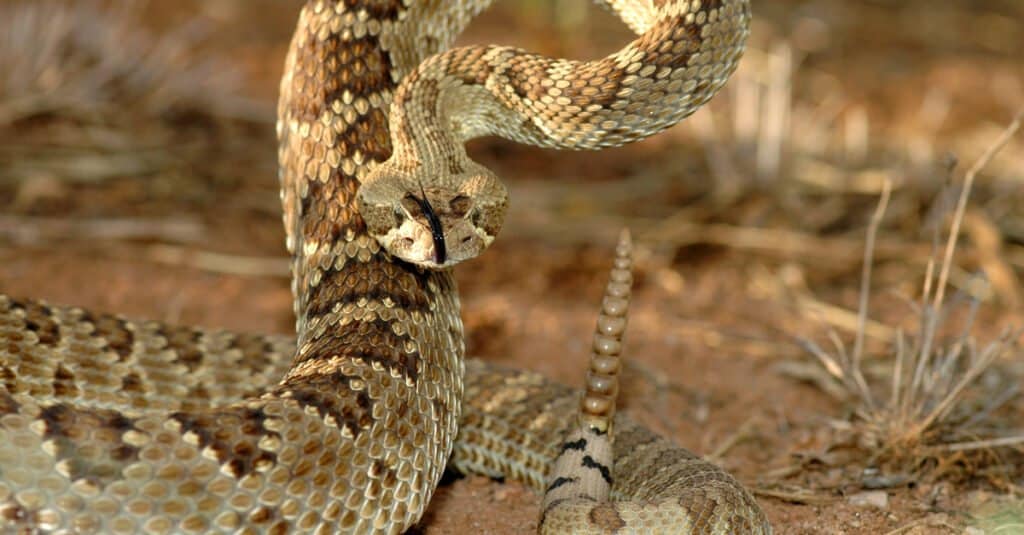
The Mojave rattlesnake, including both of its subspecies, typically grows to between 3.3 ft and 4.5 ft in length.
©Rusty Dodson/Shutterstock.com
| Mojave Rattlesnake | |
|---|---|
| Range | Southern corner of Nevada |
| Length | 39-54 inches |
The Mojave Rattlesnake, or the Mojave Green, is found only in the southern corner of Nevada. This snake grows between 39-54 inches long and lives in the desert. Its preferred habitats are generally open with little vegetation.
The body of the Mojave rattlesnake is usually some shade of brown with a greenish undertone. Although western rattlesnakes have a similar coloring, they lacks the distinctive “Mojave” green hues. Mojave rattlesnakes also have dark diamond patterns along the middle of their backs, and a white band around their tails.
The venom of the Mojave rattlesnake has a potent neurotoxic-hemotoxic blend. Bites from Mojave rattlesnakes simultaneously affect both the circulatory and nervous systems. This snake’s venom is one of the most dangerous in North America. Today bites can be treated with anti-venom, however, but it is vital to get medical attention immediately.
3. Southwestern Speckled Rattlesnake
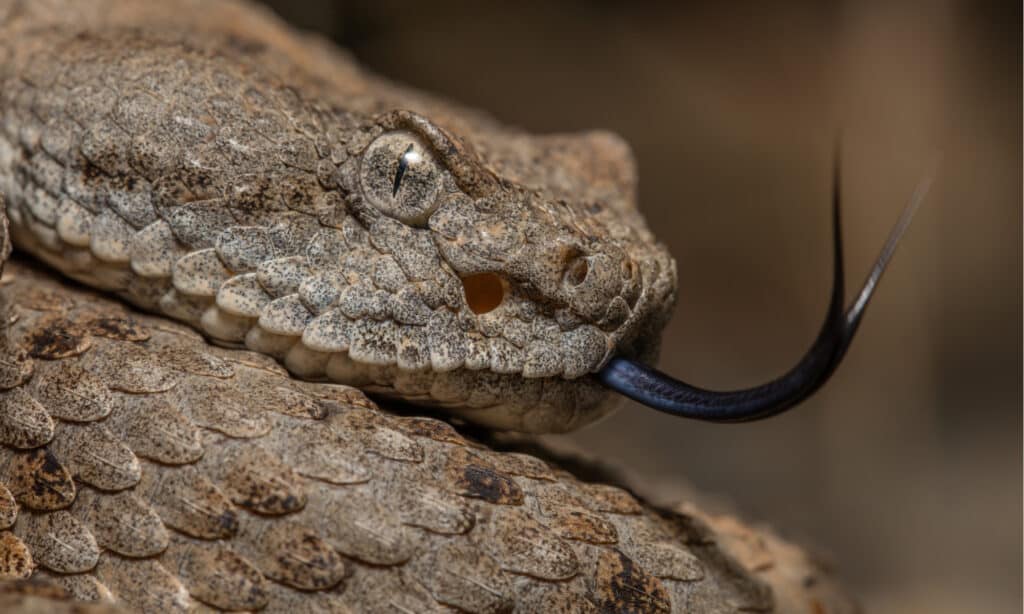
The speckled rattlesnake’s venom is twice as lethal as the western diamondback rattlesnake.
©Alexander Wong/Shutterstock.com
| Southwestern Speckled Rattlesnake | |
|---|---|
| Range | Southern Nevada |
| Length | 39 inches or less |
The Southwestern Speckled Rattlesnake lives in the dry rocky regions of Southern Nevada. This snake can also be found throughout southwestern regions of the United States and northwestern Mexico. Speckled rattlesnakes typically grow between 24 and 30 inches in length, with tan or light brown bodies. Like their name, speckled rattlesnakes have many colored “speckles” all across their bodies, as well as small dark crossbands. These snakes come in many different colors, depending on where they live and what colors will help them to blend in best. Their camouflage works so well, you may not see a speckled rattlesnake even when you are standing right in front of it!
4. Panamint Rattlesnake
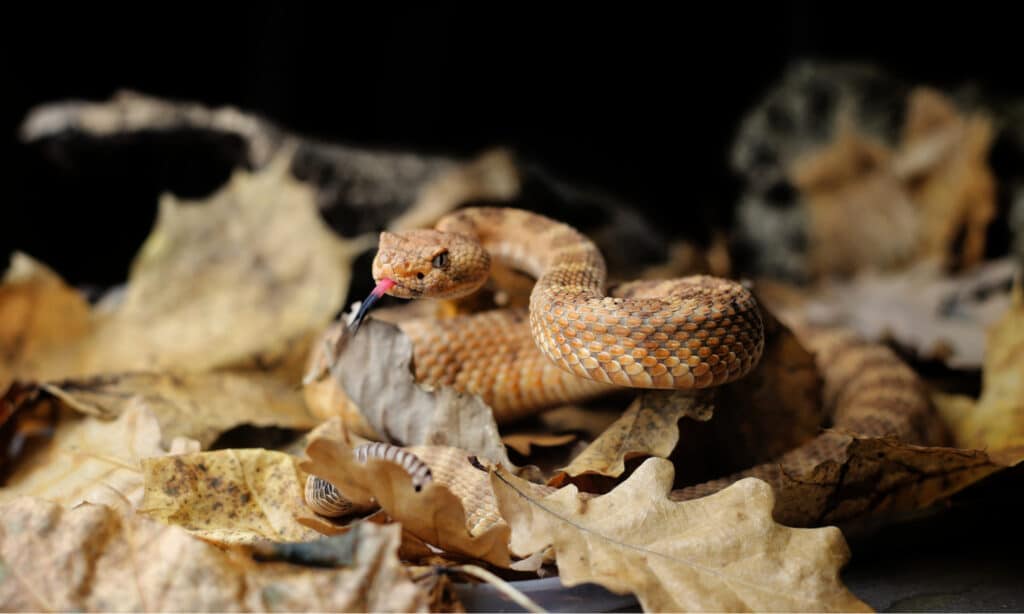
The Panamint rattlesnake lives in California and Nevada.
©Marina Kehl/Shutterstock.com
| Panamint Rattlesnake | |
|---|---|
| Range | Southwest Nevada along the California-Nevada border |
| Length | 23-52 inches |
The Panamint rattlesnake lives in the southwestern regions of Nevada, right along the California-Nevada border. The center of its range is the Panamint Mountains in Death Valley, which is where this snake gets its name. Panamint rattlesnakes prefer the open space of desert regions, although they can also be found in the mountains as well.
The Panamint rattlesnake is 23-52 inches long and comes in a wide variety of different colors, depending on which color best blends into its environment. Common base colors for the Panamint rattlesnake include tan, orange or yellow tones, off-white, and gray. Patterned blotches run along the length of the body, usually gray, reddish-brown, or brown, and end in a dark band near the rattle.
5. Mojave Desert Sidewinder Rattlesnake
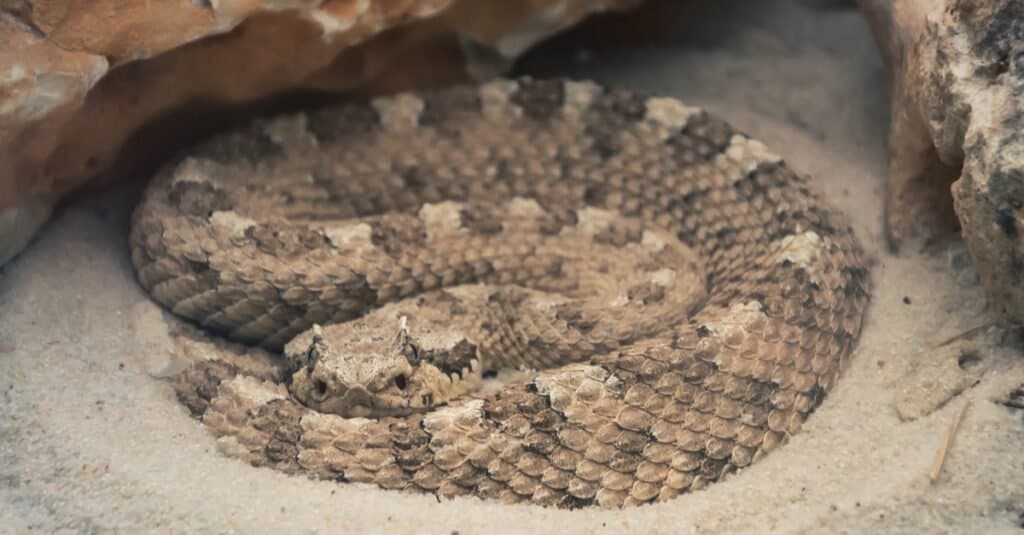
The Mojave Desert sidewinder has a dark cheek stripe running from each eye to the back corner of the mouth.
©RA fotografia/Shutterstock.com
| Mojave Desert Sidewinder | |
|---|---|
| Range | Southern Nevada |
| Length | 17-30 inches |
The Mojave Desert sidewinder rattlesnake is found in southern Nevada. Its range also spreads through the southwest deserts of the United States and northwest Mexico. It is one of the smallest species of rattlesnake, measuring between 17 and 30 inches long. The sidewinder gets its name from how it moves. This rattlesnake slithers in a sideways, winding motion across the sand, leaving J-shaped marks behind. This form of locomotion allows the sidewinder to move up sandy slopes with ease.
Mojave Desert sidewinders can be gray, brown, tan, cream, or pink. They have darker, geometric blotches running down the middle of their backs, with smaller patches scattered across their bodies that help them to blend in with the sand. They have a dark stripe that runs from the eye down to the corner of the mouth. Mojave Desert sidewinders have horn-like scales right above their eyes, which is why sometimes they are called horned rattlesnakes.
Sidewinders bury themselves partially in the sand and wait for their prey to pass by. The venom of sidewinder rattlesnakes is weaker than that of most other rattlesnakes, and their venom glands are smaller. This makes the sidewinder rattlesnakes less toxic than others, but they are still dangerous, and you should always stay out of the way of any rattlesnake.
6. Great Basin Rattlesnake (Western Rattlesnake)
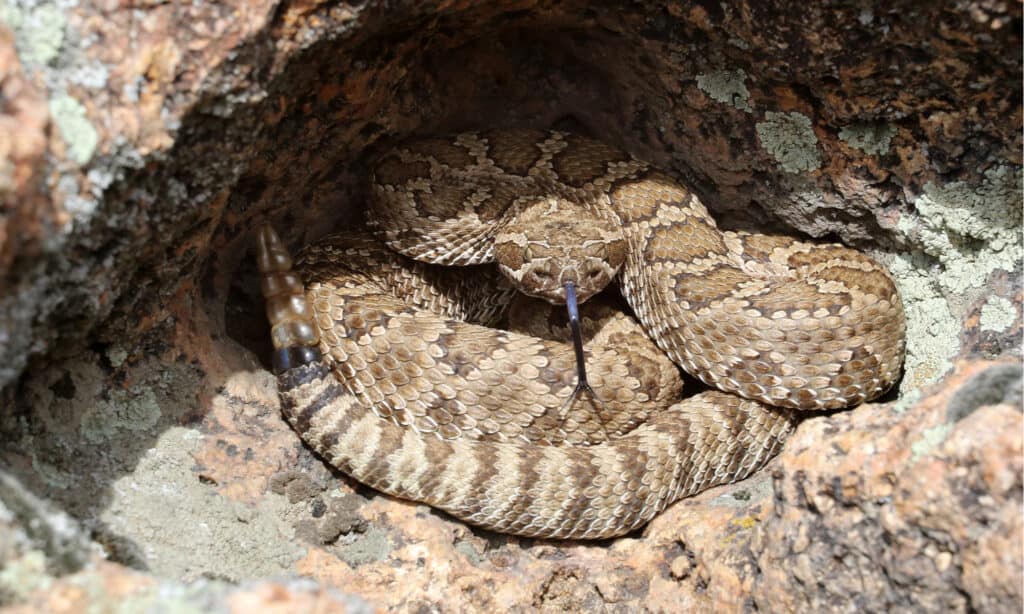
Great Basin Rattlesnakes and the Great Basin gopher snake are very similar in appearance.
©Randy Bjorklund/Shutterstock.com
| Great Basin Rattlesnake | |
|---|---|
| Range | All of Nevada except for southernmost tip |
| Length | 30-36 inches |
The Great Basin rattlesnake lives all throughout Nevada, except for the southernmost tip of the state. This snake can be found in habitats with grassy plains, rocky or stony canyons and hillsides, and agricultural regions. The Great Basin rattlesnake gets its name from its large range, which covers the Great Basin region of the United States. This snake is a subspecies of the western rattlesnake.
In Nevada, Great Basin rattlesnakes typically grow between 30 and 36 inches in length. These snakes have thick bodies that are light yellow, light grey, light brown, or olive brown. There are also dark blotches with pale centers down the middle of the snake’s back. The venom of the Great Basin rattlesnake is complex, with myotoxins, hemotoxins, and possibly neurotoxins.
A nonvenomous snake, the Great Basin gopher snake, looks very similar to the Great Basin rattlesnake. The Great Basin gopher snake is also yellow or light brown with darker blotches lining the length of its body. In addition, this gopher snake confuses its enemies by vibrating its tail against leaf litter so that it looks and sounds like a rattlesnake. Unlike a rattlesnake, the Great Basin gopher snake has a rounded, oval-shaped head like a bullet, and it does not have a rattle on the end of its tail. Unfortunately, when people see a Great Basin gopher snake, they often jump to conclusions and assume it is a rattlesnake, killing it out of fear. Although the Great Basin gopher snake looks like the Great Basin rattlesnake, it is a nonvenomous and harmless snake. The Great Basin rattlesnake has a thicker body and a large triangle-shaped head.
Summary of 6 Types of Rattlesnakes in Nevada
Here’s a recap of the six rattlesnake species found in the state of Nevada:
| Number | Rattlesnake | Range | Length |
|---|---|---|---|
| 1 | Western Diamondback Rattlesnake | Extreme south of Nevada | 48-72 inches |
| 2 | Mojave Rattlesnake | Southern corner of Nevada | 39-54 inches |
| 3 | Southwestern Speckled Rattlesnake | Southern Nevada | 39 inches or less |
| 4 | Panamint Rattlesnake | Southwest Nevada along the California-Nevada border | 23-52 inches |
| 5 | Mojave Desert Sidewinder Rattlesnake | Southern Nevada | 17-30 inches |
| 6 | Great Basin Rattlesnake | All of Nevada except for southernmost tip | 30-36 inches |
Black Snakes in Nevada
The speckled rattlesnake is one of the few dangerous black snakes in Nevada. The state is also home to other black snakes such as the Western shovelnose snake, ring-necked snake, the Eastern kingsnake, desert striped whipsnake, long-nosed snake, valley garter snake, and Sierra garter snake.
Western shovelnose snakes can be found in southern Nevada, typically in rocky canyons, valleys, and sandy deserts. They are harmless to humans and have unusually flattened snouts shaped like shovels, which they use to dig rapidly through sand. Long-nosed snakes also have distinctive snouts, which are elongated and a little upturned. They can be seen in the south half of Nevada and along the state’s northwestern edge.
Ring-necked snakes are mildly venomous, secretive snakes that hide most of the time and live in southern Nevada in a range of habitats. Eastern kingsnakes are present in forests, grasslands, deserts, rocky fields, and sometimes close to riverbanks and swamps. Fast-moving desert striped whipsnakes are located throughout the state of Nevada in areas with rocky streams, flatlands, and mountains.
Garter snakes have a mild venom that they use to subdue their prey and are not harmful to humans. Valley garter snakes and Sierra garter snakes can be found in the westernmost part of Nevada. Read more about black snakes in Nevada here.
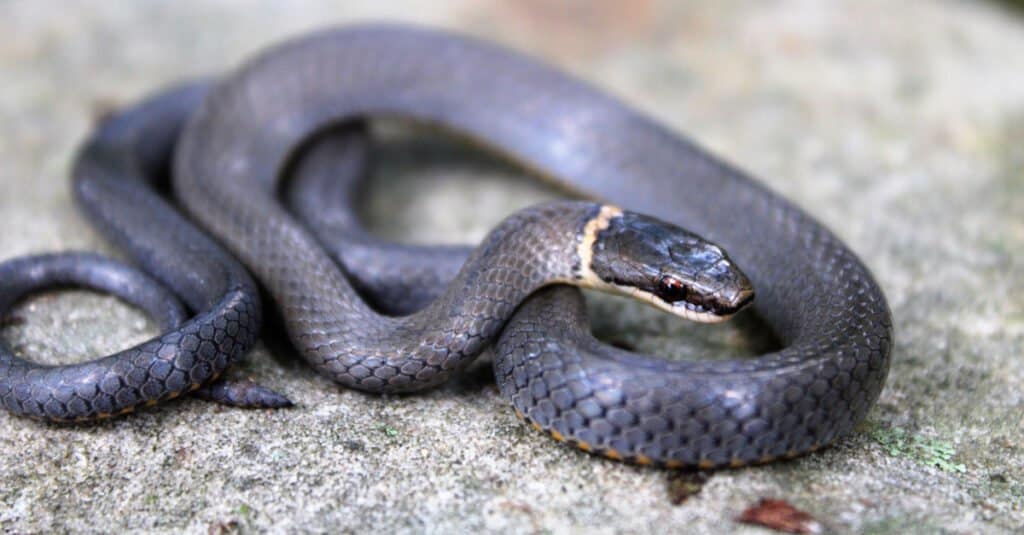
Ring-necked snakes are present in southern Nevada.
©Tucker Heptinstall/Shutterstock.com
The photo featured at the top of this post is © Randy Bjorklund/Shutterstock.com
Discover the "Monster" Snake 5X Bigger than an Anaconda
Every day A-Z Animals sends out some of the most incredible facts in the world from our free newsletter. Want to discover the 10 most beautiful snakes in the world, a "snake island" where you're never more than 3 feet from danger, or a "monster" snake 5X larger than an anaconda? Then sign up right now and you'll start receiving our daily newsletter absolutely free.
Thank you for reading! Have some feedback for us? Contact the AZ Animals editorial team.






